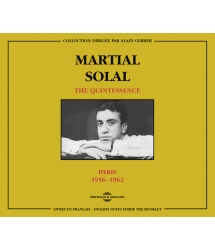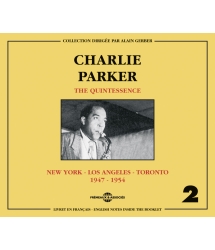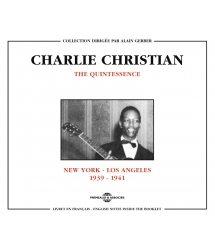- Our Catalog
- Philosophy
- Philosophers of the 20th century and today
- History of Philosophy (PUF)
- Counter-History and Brief Encyclopedia by Michel Onfray
- The philosophical work explained by Luc Ferry
- Ancient thought
- Thinkers of yesterday as seen by the philosophers of today
- Historical philosophical texts interpreted by great actors
- History
- Books (in French)
- Social science
- Historical words
- Audiobooks & Literature
- Our Catalog
- Jazz
- Blues
- Rock - Country - Cajun
- French song
- World music
- Africa
- France
- Québec / Canada
- Hawaï
- West Indies
- Caribbean
- Cuba & Afro-cubain
- Mexico
- South America
- Tango
- Brazil
- Tzigane / Gypsy
- Fado / Portugal
- Flamenco / Spain
- Yiddish / Israel
- China
- Tibet / Nepal
- Asia
- Indian Ocean / Madagascar
- Japan
- Indonesia
- Oceania
- India
- Bangladesh
- USSR / Communist songs
- World music / Miscellaneous
- Classical music
- Composers - Movie Soundtracks
- Sounds of nature
- Our Catalog
- Youth
- Philosophy
- News
- How to order ?
- Receive the catalog
- Manifesto
- Dictionnary











- Our Catalog
- Philosophy
- Philosophers of the 20th century and today
- History of Philosophy (PUF)
- Counter-History and Brief Encyclopedia by Michel Onfray
- The philosophical work explained by Luc Ferry
- Ancient thought
- Thinkers of yesterday as seen by the philosophers of today
- Historical philosophical texts interpreted by great actors
- History
- Books (in French)
- Social science
- Historical words
- Audiobooks & Literature
- Our Catalog
- Jazz
- Blues
- Rock - Country - Cajun
- French song
- World music
- Africa
- France
- Québec / Canada
- Hawaï
- West Indies
- Caribbean
- Cuba & Afro-cubain
- Mexico
- South America
- Tango
- Brazil
- Tzigane / Gypsy
- Fado / Portugal
- Flamenco / Spain
- Yiddish / Israel
- China
- Tibet / Nepal
- Asia
- Indian Ocean / Madagascar
- Japan
- Indonesia
- Oceania
- India
- Bangladesh
- USSR / Communist songs
- World music / Miscellaneous
- Classical music
- Composers - Movie Soundtracks
- Sounds of nature
- Our Catalog
- Youth
- Philosophy
- News
- How to order ?
- Receive the catalog
- Manifesto
- Dictionnary
DUKE ELLINGTON
Ref.: FA5682
Label : Frémeaux & Associés
Total duration of the pack : 2 hours 32 minutes
Nbre. CD : 2
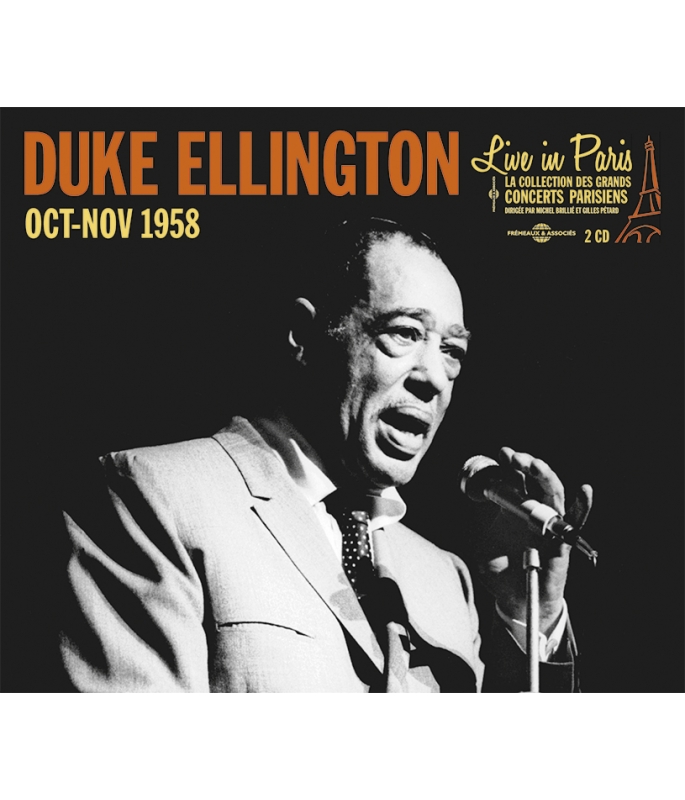
Incandescent composer, modernizer, and charismatic voodoo dandy… Duke Ellington was a larger-than-life character whose impact on jazz history was revolutionary. Also a fi ne pianist, Duke’s arranging skills were so great that his main instrument was in fact the orchestra, for which he wrote many major works as well as settings for some of the greatest soloists. This 2CD set was recorded in Paris during Duke’s historic European tour in 1958 and, with music unavailable for a long time, this is part of the legacy of one of the most important American artists of the 20th century. Patrick FRÉMEAUX
The Live in Paris collection by Michel Brillié allows listeners to hear previously-unreleased recordings (made at concerts and private- or radio-sessions) by the great 20th stars in jazz, rock & roll and song. These “live” takes, and the artists’ rapport with their audiences, gives these performances an additional soul and sensibility in counterpoint to the rigorous demands of studio recordings. Particular care was taken when restoring the sound of these tapes in order to meet CD standards while preserving the original colours of the period. Patrick FRÉMEAUX & Gilles PÉTARD
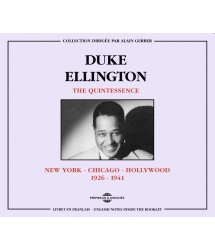
NEW YORK - CHICAGO - HOLLYWOOD 1926 - 1941
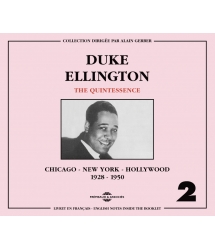
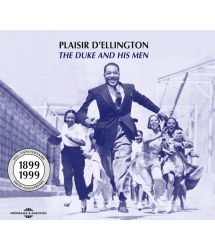
THE DUKE AND HIS MEN 1899 - 1999



-
PisteTitleMain artistAutorDurationRegistered in
-
1Take The A TrainDuke Ellington00:03:251958
-
2Medley / Black And Tan Fantasy / Creole Love Call / The MoocheDuke Ellington00:09:081958
-
3Newport UpDuke Ellington00:05:131958
-
4Deep PurpleDuke Ellington00:04:091958
-
5Harlem AirshaftDuke Ellington00:04:091958
-
6Such Sweet Thunder Sonnet To Hank CinqDuke Ellington00:04:531958
-
7Sophisticated LadyDuke Ellington00:04:081958
-
8Kinda Dukisch Rockin' In RhythmDuke Ellington00:06:281958
-
9What Else Can You Do With A DrumDuke Ellington00:02:091958
-
10TogetherDuke Ellington00:03:191958
-
11Jepp's BluesDuke Ellington00:03:331958
-
12All Of MeDuke Ellington00:02:471958
-
13Things Ain't What They Used To BeDuke Ellington00:04:031958
-
14El GatoDuke Ellington00:04:501958
-
15Stompu JonesDuke Ellington00:04:161958
-
16Hi Fi Fo FumsDuke Ellington00:09:191958
-
PisteTitleMain artistAutorDurationRegistered in
-
1Medley / Don't Get Around Much Anymore / Do Nothin Till You HearDuke Ellington00:18:481958
-
2Diminuendo And Crescendo In BluesDuke Ellington00:12:191958
-
3TenderlyDuke Ellington00:05:301958
-
4On The Sunny Side Of The StreetDuke Ellington00:02:481958
-
5C Jam BluesDuke Ellington00:04:341958
-
6Duke's PlaceDuke Ellington00:02:561958
-
7CaravanDuke Ellington00:06:401958
-
8Take The A TrainDuke Ellington00:06:331958
-
9Mc BluesDuke Ellington00:06:221958
-
10Vip BoogieDuke Ellington00:03:081958
-
11Jam With SamDuke Ellington00:03:371958
-
12Hawk TalksDuke Ellington00:03:151958
Ellington live FA5682
Duke Ellington
oct-nov 1958
Live in Paris
La collection des grands concerts parisiens
Dirigée par Michel Brillié et Gilles Pétard
2 CD
Les tournées du grand Duke
« My people… mon groupe… En fait je fais partie de plusieurs groupes différents…Voyons… Je suis dans le groupe des pianistes…Dans le groupe de ceux qui écoutent… Je fais aussi partie du groupe de ceux qui aspirent au dilettantisme… Ah oui, et aussi de celui des amateurs de beaujolais. »
A cette éclectique auto-description, retrouvée dans un docu de 1994 de la BBC, Reminiscing in Tempo, Duke Ellington aurait pu ajouter : et du groupe des gens sans domicile fixe. L’homme n’a jamais possédé de maison, c’était l’apôtre du mouvement perpétuel.
Duke Ellington se définissait comme un « ménestrel itinérant ». Il pouvait composer partout, «le train est l’un des meilleurs endroits pour ça,…avec le lit. ». Une idée lui vient-elle lors d’un voyage en avion, il enlève sa chemise pour noter les notes de musique sur sa manche. L’avion, d’ailleurs, ça n’était pas son truc. Il ne s’y est résolu que contraint et forcé par les exigences des tournées enchaînant date après date, ville après ville, pays après pays. Non, Ellington aimait peut-être d’abord la route. En particulier quand elle était tracée en compagnie de son musicien-chauffeur attitré, le saxophoniste Harry Carney. Les deux amis de 50 ans parcouraient les kilomètres dans la Lincoln Imperial de Carney, Duke à l’avant à côté du chauffeur, lisant les cartes routières, rassuré par la conduite tranquille de son taciturne compagnon.
Et puis le train. Là encore, c’était un endroit privilégié de création. Frank Ténot, « un très vieil ami d’enfance de Duke » comme il se décrit malicieusement dans Frankly Speaking, affirme avoir été le témoin d’une scène magique : « J’ai entendu un soir, dans un wagon restaurant entre les Açores et l’Irlande, une œuvre que je n’oublierai jamais. Ellington jouait du couteau sur trois verres, l’un empli de bordeaux, l’autre de blanc d’Alsace, le troisième de Loupiac ; de sa fourchette, il effleurait un quart Perrier à moitié vide et un cendrier en porcelaine des Indes… »
Une fois arrivé, Duke allait à son hôtel. Jamais le même que sa troupe de 14 cadors. En 1960 à Paris, par exemple, il descend au très chic Hôtel de la Trémoille, près de l’avenue Montaigne. Louis Armstrong occupe la suite au dessus de la sienne. Les deux sont là pour tourner le film de Martin Ritt, Paris Blues. Selon le magazine Ebony, Armstrong répétait ses morceaux la nuit, et Duke n’arrivait pas à fermer l’œil… L’orchestre, lui, se débrouillait comme il pouvait. Les tarifs des hôtels parisiens étaient souvent trop élevés pour les musiciens du Duke. Frank Ténot : « Harry Edison, Henry Cocker, Al Grey ou Harry Carney, il m’est arrivé de les entendre me demander l’autorisation de dormir dans une loge de l’Olympia, horrifiés qu’ils étaient par le prix d’une chambre habitable dans un hôtel de la capitale…Les salaires de ces artistes en voyage leur assuraient tout juste la couverture de leurs besoins immédiats : logement et nourriture. » Quelques années plus tard, l’un des bassistes d’Ellington, Aaron Bell, en voyant la note de l’hôtel (plutôt chic) où il vient de résider le temps d’un concert, gémit : « Je vais faire aménager l’étui de ma basse pour pouvoir y dormir… »
Lendemain, jour de concert. Le rituel du réveil du Duke était semble-t-il immuable : Le garçon d’étage pénétrait délicatement dans sa chambre en poussant son petit déjeuner dressé sur une table d’un blanc immaculé. Il s’attablait alors, devant une robuste collation : steak, pommes de terre au four, accompagné uniquement d’eau chaude… Ni café ni thé. Ce premier repas était selon ses dires son « moment fondateur : comme je ne sais pas comment ma journée va tourner, je ne prends pas de risques avec le petit déjeuner.»
Passons sur sa passion des vêtements ou des chaussures. Duke Ellington avait fait fabriquer des malles spéciales pour transporter toute sa garde robe. L’homme était très soucieux de son élégance. Chaussures en croco, en daim, de toutes les couleurs. Costumes impeccables : si un bouton de veste venait à tomber, le costume était définitivement écarté, et mis à la disposition des musiciens de l’orchestre. Le pire, pour Ellington qui était extrêmement superstitieux, c’était quand un bouton venait à tombe sur scène… Duke avait toute une panoplie de tabous. Il ne portait pas certaines couleurs, comme le jaune ; il n’acceptait de cadeaux de chaussures, et lui même n’en offrait jamais. Juan Tizol : « Dans sa loge, il ne voulait pas que l’on siffle ou que l’on mange des cacahuètes… »
Puis la journée se déroule : coups de fil à sa famille, à ses amis, et diverses affaires courantes. L’argent aussi sans doute, même si l’homme ne s’y intéressait que par obligation. Ellington savait être généreux. Pendant les années difficiles, il a financé son orchestre de jazzstars avec ses droits d’auteur de l’ASCAP, la SACEM d’outre atlantique. Lors d’un passage en Angleterre, le musicien Humphrey Lyttelton lui demande le secret de la fidélité de ses musiciens : « Hé bien Humphrey, c’est vrai qu’il vous faut un truc pour ça…Et moi le mien, c’est que je leur donne de l’argent. »
Mais parfois Ellington n’avait pas toujours une bonne mémoire…Dizzy Gillespie : « Un jour, j’ai fait un album avec Duke, un peu par hasard (Jazz Party, NDR). J’étais dans le coin avec ma trompette, j’ai joué, ça a été enregistré et c’est paru. Et après, comme je n’avais rien reçu, je l’ai dit à Duke, gentiment. Il a souri et m’a répondu : ‘Diz, tu sais, je ne pourrai jamais te payer à ta valeur réelle…’ J’ai aussi souri et j’ai dit, ‘Pas de souci, Duke, du moment que tu me payes !’ C’est ce qu’il a fini par faire quelque temps après. »
Paris Concert Time
Duke aimait vraiment jouer à Paris. Laurent Mignard, qui avec le Duke Orchestra perpétue la tradition et le swing d’Ellington, confirme dans son interview à Pop Matters : « Duke aimait Paris et La France. La joie de vivre, le sens du bon goût. L’élégance de la langue française. Et les salles parisiennes ; l’Olympia, la Salle Pleyel, Le Théâtre des Champs-Élysées… Mais par-dessus tout, il préférait l’Alhambra. Parce que c’était un cabaret, et que les cabarets lui rappelaient le Cotton Club. »
Paris était aussi la ville refuge de Billy Strayhorn, l’artiste et l‘ami qu’Ellington appelait, plutôt que son alter ego, « mon bras droit, mon bras gauche, mes yeux, les ondes cérébrales de mon crâne ». Dans la ville, Strayhorn pouvait en toute liberté vivre à sa guise ses diverses singularités. Ecumer les boites de jazz, en particulier le Mars Club, près des Champs Elysées. Le club avait vu passer les plus grandes, Billie, Sarah, Carmen, Eartha, et aussi les écrivains expat’, James Baldwin, Irwin Shaw. Quand Strayhorn était en ville, il venait au club et s’asseyait au piano. De fait, pendant les tournées ellingtonniennes, Paris était sa base arrière.
En cette fin d’année 1958, Ellington va donner cinq concerts à Paris : les 28 et 29 Octobre, deux concerts, au Palais de Chaillot et à l’Alhambra ; le 20 Novembre, un dernier passage à la salle Pleyel. Ce dernier a bénéficié d’une captation télévisée qu’on a pu revoir récemment. Pour Jazz Magazine, les 5 concerts sont restés parmi les manifestations les plus importantes jamais réalisées à Paris ; et c’est le 29 que « les musiciens donnèrent le meilleur d’eux-mêmes, même si l’acoustique défavorisa l’audition. »
En janvier 1959, le magazine revient sur la série de concerts et titre : « Ellington sur scène : 14 phénomènes et un grand chef ».
Au…dernier rang de ces « phénomènes », le batteur préféré du Duke : Sam Woodyard. « Sam connaît la partition, mais il nous connaît encore mieux » confie-t-il à Frank Ténot. « Il sait donc dans quel état nous sommes le soir du concert. Et s’il souligne, accompagne et cogne, Il prévoit aussi le fiasco du soliste ou le flou d’un tutti, et le compense. La scène peut s’effondrer, les lumières s’éteindre, Sam, lui continue de swinguer. »
Sans doute en prévision du magistral solo de batterie de « Hi Fi Fo Fum », Duke Ellington demanda un soir à son ami Frank: « Sois gentil, pendant le solo, viens me parler en coulisse et aie l’air très fâché avec moi. » Je m’informe : « Pourquoi ? Qu’est ce qui ne va pas ? » Le Duke : « C’est un moment délicat, car l’orchestre, moi compris, abandonne la scène pendant les 10 minutes où Sam Woodyard se déchaîne sur ses caisses. Je n’ai pas le temps de m’enfermer dans ma loge. Alors les Hodges, Gonsalves, Cootie viennent m’enquiquiner avec des demandes de primes et d’augmentations. Si je suis en discussion avec toi, ils me laisseront tranquille… »
Et sur scène, comment était l’ambiance dans les rangées ? Les avis sont partagés. Pour Cootie Williams, tout roulait : « Chez Duke, nous étions une bonne équipe de copains. Le Duke était un chef extraordinaire : dans son orchestre, chacun a un rôle bien déterminé. Il choisit des types qui ont des styles divers mais qui s’entendent bien musicalement et humainement. »
Mais d’autres décrivent un univers où tous les coups sont permis. Le tromboniste Lawrence Brown arrive dans l’orchestre et découvre qu’il n’y a pas de partition pour un troisième trombone. Finalement, il se compose sa propre partition. Le Duke Ellington Orchestra avait une réputation dans le métier pour son esprit particulier et capricieux. Le trompettiste Shorty Baker se souvient de la première fois où il a joué avec l’orchestre : « Pendant une semaine, les gars m’ont laissé jouer une partition sans me dire que tout avait été changé ! » Bill Berry lui aussi s’est retrouvé dans la même situation. « Il y avait bien des tonnes de partitions, mais rien n’était titré, et de toute façon on ne s’en servait pas. » Alors Bill restait là, assis, la trompette à la main. « Mets ta trompette aux lèvres, Bill » lui a ordonné le Duke, « Même si t’as rien à jouer, fais de la figuration, ça embellit mon pupitre de cuivres. »
Le moment est venu de pénétrer sur scène. Ellington va donner une fois de plus une soirée privée dont il est « l’invité d’honneur ». A Paris, une fois encore. « Avec mes musiciens, ces géants… C’est comme organiser un festival de jazz 52 semaines par an – d’ailleurs, s’il y avait 53 semaines, on les ferait tout autant… » Alors, Ellington, poigne de fer avec ses quatorze têtes de mule ? « Je n’ai aucun penchant pour le rôle de boss. Moi j’aime d’abord écouter mon orchestre. C’est ça qui me plait. Le style disciplinaire, tu es en retard, tu as une amende de 10 dollars… Ce n’est pas mon truc. Un type peut très bien avoir 10 minutes de retard et jouer comme une bête les 5 minutes qui suivent, j’oublie tout. »
On lui repose la question lors d’une interview extensive : « Duke Ellington, qu’est ce que vous préférez comme activité…composer, jouer, diriger ? Réponse : « je préfère écouter. »
C’est à vous maintenant d’en faire autant.
Michel BRILLIÉ
© Frémeaux & Associés 2017
Sources
Swedish TV, February 03, 1963: Duke Ellington Interview. Part1
Jazz Journal, March 1959: The Dankworth - Lyttelton Interview
BBC One, May 10, 1994: Reminiscing in Tempo
Pop Matters.com, June 2, 2011: Duke and Paris, by Matthew Asprey
Music is My Mistress, by Edward Kennedy Ellington (Da Capo Press, 1973)
Traduction Clément Boqué et Françoise Jackson. Avec Christian Bonnet, président de la Maison du Duke (Slatkine & Cie, 2016)
Frankly Speaking, par Frank Ténot (Editions du Layeur, 2004)
From Birdland to Broadway, by Bill Crow (Oxford University Press, 1992)
Duke Ellington Live in Paris Oct-Nov 1958
The Tours of the Grand Duke
“My people… I’m in several groups… I’m in the piano players’… I’m in the group of the listeners. The group of those who aspire to be dilletantes… And oh yes ! Those who appreciate Beaujolais.”
To this eclectic self-description, included in the 1994 BBC documentary Reminiscing in Tempo, Duke Ellington could have added: and the homeless people’s group. For the man never owned a home anywhere; he was the apostle of perpetual movement.
Duke Ellington defined himself as “a pedestrian minstrel”. He would compose music in the oddest of places: “I think on trains is one of the best places, and so many times in bed.” Once he came up with a musical idea while traveling on a plane. He took off his shirt to write the notes on his sleeve. Flying wasn’t really his thing. He reluctantly brought himself to do it because of un-ending tours with back-to-back gigs, cities, countries... What Ellington really enjoyed was car trips. Especially when he hit the road together with his regular musician and chauffeur, sax man Harry Carney. The two friends of fifty years would travel for miles in Carney’s Lincoln Imperial, Duke sitting next to the driver, watching the road map, reassured by his friend’s calm and safe driving.
And then trains, too. It was a special place for creation . Frank Ténot, “a childhood friend of Duke”, as he writes jokingly in his book Frankly Speaking, witnessed a wonderful moment of roaming creation: “One night in a dining car, somewhere between the Azores and Ireland, I heard a piece that I shall never forget. Ellington was actually playing by clinking three glasses with his knife: a glass of Bordeaux, another one with Alsace white wine, and a third with a sweet white, Loupiac. And with his fork, he was delicately stroking a half-empty bottle of Perrier and a porcelain ashtray from India.”
Once the journey was over, Duke would settle in his hotel. He never stayed in the same hotel as his gang of 14 jazz champions. In 1960 in Paris, for instance, he stayed at the very posh Hôtel de la Trémoille, close to the Avenue Montaigne. Louis Armstrong was staying there too, one floor above Ellington. Both men were in town for the shooting of Paris Blues, directed by Martin Ritt. According to Ebony Magazine, Armstrong would rehearse at night, and Duke couldn’t sleep… As for the rest of the band, they would manage as they could. The Parisian hotels room rates were often too steep for the musicians. Frank Ténot: “Harry Edison, Henry Cocker, Al Grey or Harry Carney, I often heard them ask me if they could sleep in a dressing room at the Olympia Theater, as appalled as they were by the price of a hotel room in the French capital. Their salaries just barely covered their immediate needs: lodging and food.” Some years later, Aaron Bell, one of Ellington bass players moaned at the sight of the bill of the rather classy hotel where he had stayed: “I’m going to have my bass case fixed so that I can sleep in it!”
The following day, i.-e. concert day, Duke Ellington’s awaking ritual seemed always quite the same : the room-service waiter would enter quietly pushing his breakfast table. Ellington would then settle in front of a rich snack: steak and baked potatoes, together with a pitcher of warm water. He never drank coffee or tea. This first meal was in his own words his “founding meal: because I don’t know what the day is going to be, so I don’t gamble on this one.”
Let’s now consider his passion for clothes or shoes. Ellington accumulated so many pairs of shoes that he had to have special trunks made to accommodate them. The man was extremely concerned with his looks. Shoes of all kinds, black in calf, brown in crocodile, alligator and suede, and all the other colors in the spectrum. His suits were absolutely spotless: If a button came to drop, the suit was once and for all discarded, and made available to the members of the band. Ellington was particularly superstitious: the worst thing was when a button dropped on stage. Duke’s taboos were of all kinds: he would not wear certain colors, such as yellow; he would not give or receive gifts of shoes, which suggested that the recipient would use them to walk away. Juan Tizol recalls that “Duke used to say ‘never come in my dressing room whistling or eating peanuts’.”
The day then would go on with a steady stream of phone calls to family members, to friends, and to settle current business. Money also mattered most likely, even though the man was not overly fond of it. Ellington could be a generous leader. He succeeded in keeping his band together during tough years by pumping his ASCAP royalties into the payroll. English trumpet player Humphrey Lyttelton once asked him the secret of his musicians’ loyalty: “Well you›ve got to have a gimmick, Humphrey. The one I use is to give them money.”
But sometimes, Duke Ellington’s memory on such matter was not very good. Dizzy Gillespie: “I made a record once, kind of accidental (Jazz Party). I just happened along one day with my horn and we blew and they taped it and put it out. And when I got no money, I mentioned it, very gently, to Duke. He smiled and said, ‘Well, Diz, I can’t pay you what you’re really worth… ‘So I smiled and said, ‘Don’t give it no mind, Duke, just so long as you pay me!’ And maybe a year later, he did.”
Concert Time in Paris
Duke Ellington really loved Paris and playing there. French trumpet player-band leader Laurent Mignard keeps the flame burning with his Duke Orchestra. He confirms this in his Pop Matters interview: “Duke Ellington was really fond of France and Paris. He enjoyed the joie de vivre. He enjoyed people’s views about good taste. Duke liked to speak French words in his language because it’s elegant. And I must say that the French people were completely fond of his work. Each time he came he had a very great welcoming. Yes, l’Olympia, Salle Pleyel, Théâtre des Champs-Élysées… He did many concerts. But he loved l’Alhambra. Because it was a cabaret. And cabarets reminded him of the Cotton Club.”
Paris was also a kind of refuge for Billy Strayhorn, the artist and friend that Duke called, not his alter-ego, “my right arm, my left arm, all the eyes in the back of my head, my brainwaves in his head, and his in mine.” In the city, the quiet Strayhorn was free to live out his differences. He would cruise the local jazz clubs. He was especially fond of the Mars Club, in the Champs Elysées area. The club had welcomed the greatest artists, Billie, Sarah, Carmen, Eartha, along with American expatriate writers such as James Baldwin or Irwin Shaw. When Strayhorn was in town, he would go to the club and sit at the piano. During the band’s annual European tour, Paris was his rear base.
At the end of 1958, Ellington gave five concerts in Paris: on October 28, two at the Palais de Chaillot, on October 29, two more at the Alhambra; and finally, on November 20, the last one at the Salle Pleyel. To Jazz Magazine, those five shows were among the most important events ever produced in Paris. “It was on the 29th that the musicians gave it their best in spite of bad acoustics.”
The magazine revisited the series of concerts in its January 1959 issue. It headlined “Ellington on stage: 14 giants and a great leader.”
In the last row of those prodigies sat Duke’s favorite drummer, Sam Woodyard. “Of course Sam knows the score, but he knows us even better”, he told Frank Ténot. “So he understands in what state we are at concert time. So he is there to emphasize, support or hit away; but he can also anticipate when someone is not in shape or when the guys are wobbly, and he makes up for it. Indeed, the stage could collapse, the lights go out, and Sam would keep on swinging.”
Perhaps referring to Woodyard’s incredible drum solo in “Hi Fi Fo Fum”, Duke Ellington once asked his friend Frank: “Do me a favor Frank. During the solo, follow me backstage and talk to me like you’re mad at me.” I reply, “Why? Is anything wrong?” Duke: “It’s a tricky situation for me… The whole band, myself included, leaves the stage during the ten minutes Sam Woodyard lashes out at his drums. There’s not enough time for me to retreat to my dressing-room. And so all the guys, Hodges, Gonsalves, Cootie come up to me and bother me with pay raise demands and so on. If they see us arguing together, they will leave me alone.”
How was the ambiance on stage, in the bandstand? Opinions are divided on the matter. Everything was fine for trumpet player Cootie Williams who recalled his days as “a great bunch of buddies. The Duke was a fantastic leader. Everybody had a definite part to play. He selected guys with various styles, but who got along well, as musicians or human beings.”
For others, it was a world where anything went. When trombonist Lawrence Brown joined the group, he found out that there were no third trombone parts, so he had to sort of compose his own parts… The band had a reputation for idiosyncrasy and capriciousness. Some members of the trumpet section weren’t on speaking terms for years. Shorty Baker: “When I first joined the band, they let me sit there playing the wrong notes for a week without telling me the parts had been changed!” Bill Berry (tp) experienced something similar when he first started with Duke Ellington. “I had a library of music, 6 inches thick, but none of it was titled, and we didn’t play it anyway! There wasn’t any music.” Since he had nothing to play, Bill just sat there. Duke told him, “Put your horn in your mouth. Dress up my bandstand, whether you’ve got anything to play or not.”
Then it was time to enter the stage. “Every night I give a house party and I’m the guest of honor…” Once more it was Paris. “My musicians, jazz giants… It’s like organizing a jazz festival 52 weeks a year… We would do 53 but there are not 53 weeks.” Was Ellington an iron-handed chef with his fourteen men? “I have no aspiration to being a boss. I like to have a band of musicians whom I like to hear myself. That’s my kick. To be a boss you have to be a disciplinarian. You are late, you have a $10 fine…This is not for me. A guy can come ten minutes late and blow so much in the next five that it makes you forget.”
The question was asked one more time during an extensive interview: “Duke Ellington, what do you enjoy the most: Composing, playing, directing?” The Duke answered: “I get my kicks listening.”
Now’s the time for you to do just that.
Michel BRILLIÉ
© Frémeaux & Associés 2017
CD1
1. Take the “A” Train (Billy Strayhorn) 3’25
2. Medley: Black and Tan Fantasy / Creole Love Call / The Mooche (Duke Ellington /Bubber Miley / Irving Mills) 9’08
3. Newport Up (Duke Ellington / Billy Strayhorn) 5’13
4. Deep Purple (Mitchell Parish - Peter de Rose) 4’09
5. Harlem Airshaft (Duke Ellington) 4’09
6. Such Sweet Thunder / Sonnet to Hank Cinq (Duke Ellington / Billy Strayhorn) 4’53
7. Sophisticated Lady (Mitchell Parish - Duke Ellington) 4’08
8. Kinda Dukish / Rockin’ in Rhythm (Duke Ellington / Harry Carney) 6’28
9. What Else Can You Do with a Drum (Duke Ellington / Billy Strayhorn) 2’09
10. Together (R. Taylor - W. Hardy) 3’19
11. Jeep’s Blues (Duke Ellington / Johnny Hodges) 3’33
12. All of Me (Gerald Marks / Seymour Simons) 2’47
13. Things Ain’t What They Used to Be (Ted Parson - Mercer Ellington) 4’03
14. El Gato (Duke Ellington) 4’50
15. Stompy Jones (Duke Ellington) 4’16
16. Hi-fi Fo Fums (Duke Ellington) 9’19
Recorded by:
Europe N°1 Technical Staff
Recording Date
October 29, 1958
Recording Place
Alhambra Theater, Paris, France
Produced by:
Daniel Filipacchi, Norman Granz & Frank Ténot
Personnel
Cat Anderson trumpet
Ozzie Bailey vocal on 9 & 10
Harold Baker trumpet
Harry Carney clarinet, alto & baritone sax
Duke Ellington piano
Paul Gonsalves tenor sax
Jimmy Hamilton clarinet, tenor sax
Johnny Hodges alto sax
Quentin Jackson trombone
Ray Nance trumpet & violin
Russell Procope clarinet, alto sax
John Sanders trombone
Clark Terry trumpet, flute
Britt Woodman trombone
Jimmy Woode bass
Sam Woodyard drums
CD 2
1. Medley: Don’t Get Around Much Anymore / Do Nothin’ Till You Hear from Me / In a Sentimental Mood / Mood Indigo / I’m Beginning to See the Light / Sophisticated Lady / Caravan / I Got It Bad and That Ain’t Good / Just Squeeze Me / It Don’t Mean a Thing / Satin Doll / Solitude / I Let a Song Go Out Of My Heart (Bob Russell / Irving Mills / Manny Kurtz / Barney Bigard / Don George / Mitchell Parish / Paul Francis Webster / Lee Gaines / Billy Strayhorn / Johnny Mercer / Eddie DeLange / Henry Nemo / John Redmond Duke Ellington / Johnny Hodges / Harry James / Irving Mills / Juan Tizol) 18’48
2. Diminuendo and Crescendo in Blue (Duke Ellington) 12’19
3. Tenderly (Jack Lawrence - Walter Gross) 5’30
4. On the Sunny Side of the Street (Dorothy Fields - Jimmy McHugh) 2’48
5. C Jam Blues (Duke Ellington / Barney Bigard) 4’34
6. Duke’s Place (Bill Katts / Bob Thiele / Ruth Roberts - Duke Ellington) 2’56
7. Caravan (Irving Mills - Duke Ellington / Juan Tizol) 6’40
8. Take the “A” Train (Extended Vocal Version) (Joya Sherill / Billy Strayhorn) 6’33
9. MC Blue (Duke Ellington) 6’22
10. V.I.P. Boogie (Duke Ellington) 3’08
11. Jam with Sam (Duke Ellington) 3’37
12. Hawk Talks (Louie Bellson) 3’15
Recorded by:
Europe N°1 Technical Staff (Tracks 1 & 2)
O.R.T.F. Technical Staff (Tracks 3 to 12)
Recording Dates
October 29, 1958 (Tracks 1 & 2)
November 20,1958 (Tracks 3 to 12)
Recording Places
Alhambra Theater, Paris, France Tracks 1 & 2
Salle Pleyel, Paris, France Tracks 3 to 12
Produced by:
Daniel Filipacchi, Norman Granz & Frank Ténot
Personnel
Cat Anderson trumpet
Ozzie Bailey vocal on 1,6 & 9
Harold Baker trumpet
Harry Carney clarinet, alto & baritone sax
Duke Ellington piano
Paul Gonsalves tenor sax
Jimmy Hamilton clarinet, tenor sax
Johnny Hodges alto sax
Quentin Jackson trombone
Ray Nance trumpet & violin; vocal on 1 & 8
Russell Procope clarinet, alto sax
John Sanders trombone
Clark Terry trumpet, flute
Britt Woodman trombone
Jimmy Woode bass
Sam Woodyard drums
Compositeur incandescent, modernisateur, charismatique dandy vaudou, Duke Ellington est un personnage hors normes tant il a révolutionné et marqué l’histoire du jazz. Orchestrateur et arrangeur inégalé, son principal instrument, bien que pianiste hors pair, était l’orchestre. Ellington composait pour son big band et s’accompagnait des plus grands solistes. Enregistré à Paris pendant sa tournée européenne historique de 1958, ce coffret 2 CD contient des enregistrements depuis longtemps indisponibles de l’un des plus importants artistes américains du XXe siècle.
Patrick Frémeaux
Incandescent composer, modernizer, and charismatic voodoo dandy… Duke Ellington was a larger-than-life character whose impact on jazz history was revolutionary. Also a fine pianist, Duke’s arranging skills were so great that his main instrument was in fact the orchestra, for which he wrote many major works as well as settings for some of the greatest soloists. This 2CD set was recorded in Paris during Duke’s historic European tour in 1958 and, with music unavailable for a long time, this is part of the legacy of one of the most important American artists of the 20th century.
Patrick Frémeaux
La collection « Live in Paris », dirigée par Michel Brillié, permet de retrouver des enregistrements inédits (concerts, sessions privées ou radiophoniques), des grandes vedettes du jazz, du rock & roll et de la chanson du XXe siècle. Ces prises de son live et la relation avec le public apportent un supplément d’âme et une sensibilité en contrepoint à la rigueur appliquée lors des enregistrements studio. Une importance singulière a été apportée à la restauration sonore des bandes pour convenir aux standards CD tout en conservant la couleur d’époque.
Patrick FRÉMEAUX & Gilles PÉTARD
The Live in Paris collection by Michel Brillié allows listeners to hear previously-unreleased recordings (made at concerts and private- or radio-sessions) by the great 20th stars in jazz, rock & roll and song. These “live” takes, and the artists’ rapport with their audiences, gives these performances an additional soul and sensibility in counterpoint to the rigorous demands of studio recordings. Particular care was taken when restoring the sound of these tapes in order to meet CD standards while preserving the original colours of the period.
Patrick FRÉMEAUX & Gilles PÉTARD
DUKE ELLINGTON
CD1 : 1. Take the «A» Train 3’25 • 2. Medley: Black and Tan Fantasy / Creole Love Call / The Mooche 9’08 • 3. Newport Up 5’13 • 4. Deep Purple 4’09 • 5. Harlem Airshaft 4’09 • 6. Such Sweet Thunder / Sonnet to Hank Cinq 4’53 • 7. Sophisticated Lady 4’08 • 8. Kinda Dukish / Rockin’ in Rhythm 6’28 • 9. What Else Can You Do with a Drum 2’09 • 10. Together 3’19 • 11. Jeep’s Blues 3’33 • 12. All of Me 2’47 • 13. Things Ain’t What They Used to Be 4’03 • 14. El Gato 4’50 • 15. Stompy Jones 4’16 • 16. Hi-fi Fo Fums 9’19.
CD 2 : 1. Medley 18’48 • 2. Diminuendo and Crescendo in Blue 12’19 • 3. Tenderly 5’30 • 4. On the Sunny Side of the Street 2’48 • 5. C Jam Blues 4’34 • 6. Duke’s Place 2’56 • 7. Caravan 6’40 • 8. Take the «A» Train (Extended Vocal Version) 6’33 • 9. MC Blue 6’22 • 10. V.I.P. Boogie 3’08 • 11. Jam with Sam 3’37 • 12. Hawk Talks 3’15.
